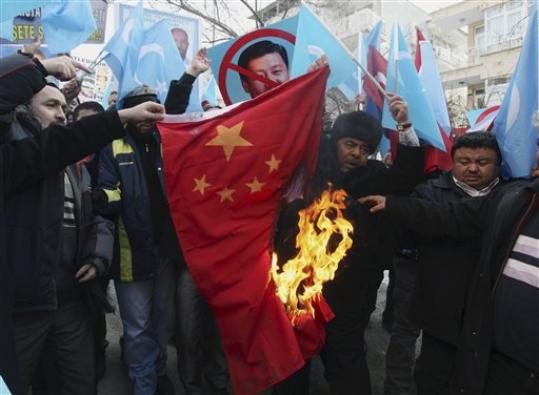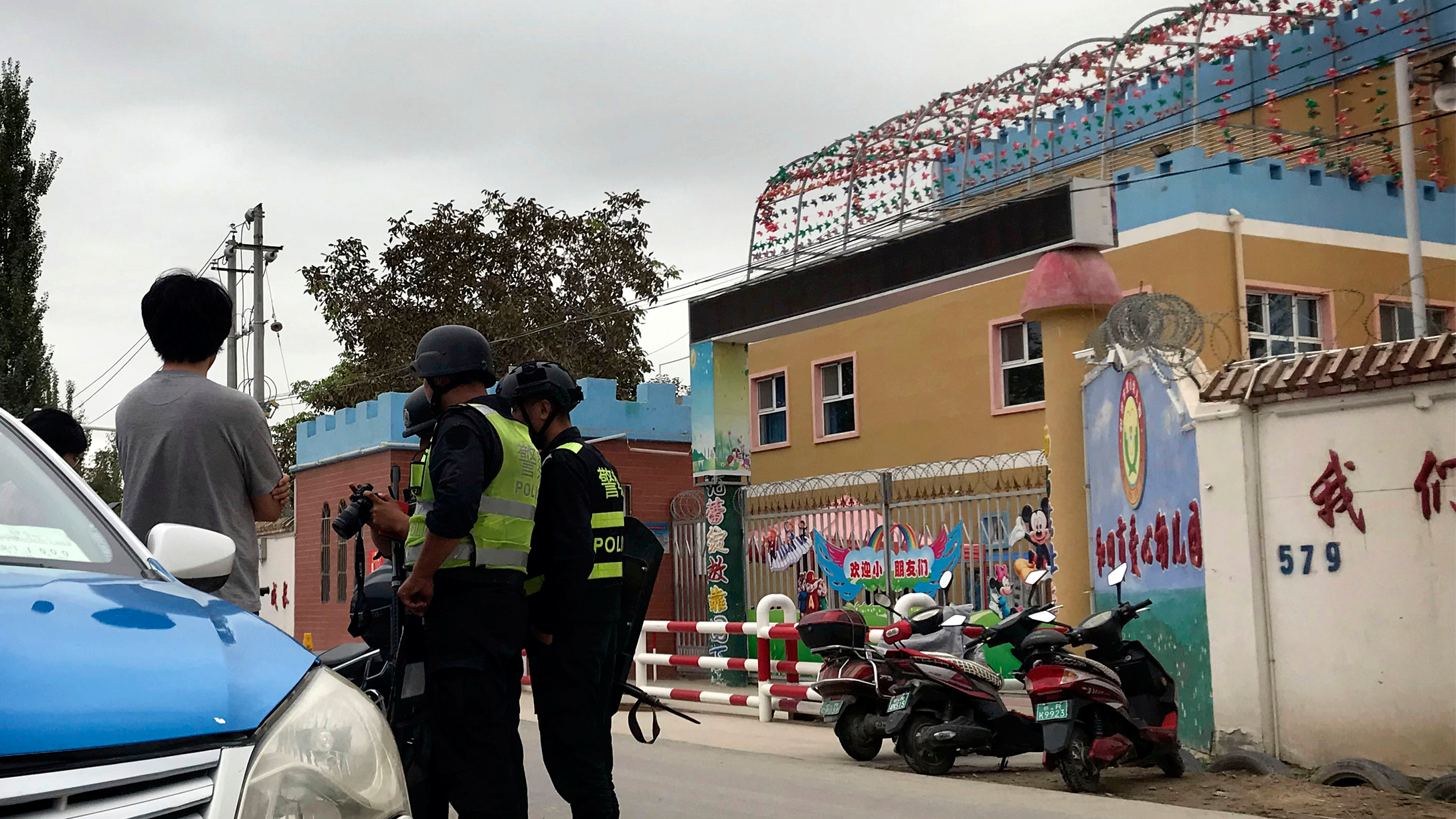The plight of more than one million Uighurs held in “re-education” camps in China’s Muslim-majority Xinjiang is a slow-burning crisis many years in the making. The Chinese government has increasingly taken the view that Islam is a radical form of ideology which it must stamp out; one common metaphor has it that China has taken to treating Islam as a mental illness. The detention of Uighurs in the prison camps appears to have begun in March 2017, but the use of heavy military force and mass surveillance in Xinjiang has gone on for years, even decades.
Before the mass detentions began, Uighurs had already been heavily surveilled by the Chinese state; a whole population was forced to install monitoring apps on their phones and GPS systems in their cars. Checkpoints were set up throughout Xinjiang. To buy even a kitchen knife required the Uighur buyer to register that knife. Large numbers of troops were stationed in Xinjiang, and military rallies were conducted as shows of intimidation.
The Chinese party-state has long seen Xinjiang as an unstable region prone to unrest, owing to outbreaks of violence it accuses of separatist uprisings, most often in knife attacks. Massive government subsidies were distributed, with the view that the region would be less prone to outbreaks of violence if it were economically prosperous; efforts were made to encourage settlement from China’s Han majority, as well as intermarriages between Uighurs and Han, to “dilute” the Uighur identity and to discourage the idea that Xinjiang is not part of China.

Photo: Cantetik2 via Wikimedia Commons (CC4.0)
Such policies have also been attempted with other non-Han “ethnic minorities” in China, of which there are 55 officially recognized groups. However, the schism may be nowhere more severe than in Xinjiang.
The aim of the Chinese government may simply be to ensure that Xinjiang remains a part of its integral territory. Alternatively it may seek a program of forced assimilation for Uighurs and other ethnic minorities—a credible reading, given that the government has forced Uighurs to give up religious and cultural practices. It is also possible that the Chinese government wishes to clear out the area for Han settlement.
What we know is that satellite images indicate that the camps in Xinjiang are expanding, and it is known that government spending on these camps is also increasing. The government is also known to sponsor Han Chinese to move into the homes of displaced Uighurs. Some may welcome this project, although there are also reports of Han Chinese being forced to stay in Uighur areas. What we know is that it does not appear that this situation will change anytime soon.
Having followed this issue for years, well before the mass detentions began last year, I sometimes wonder: How did we arrive at this point?
There are obvious parallels to be drawn between Israel/Palestine and China’s treatment of the Uighurs, as has been noted before. But even if the situation in Palestine remains dire, there is at least some global awareness regarding the issue: Channels exist that allow for images, clips, and stories to get out. But such ties may not exist for Xinjiang, with tight controls on the spread of information, limits on travel to and from the region, and close monitoring of Uighurs residing outside of China. As a result, images and stories permitting journalists and academics to construct narratives of these events are lacking.
There are simply not enough people on the ground and in a position to accurately assess information about what is currently going in Xinjiang, and to record and transmit this information on to the outside world. Sources that journalists rely on have disappeared, been arrested or worse; journalists are increasingly reluctant to make contact, knowing that even the attempt could lead to a source’s arrest. Uighurs abroad are told that they must return, or their families will be detained, with the full knowledge that if they do return, they themselves may be detained for simply having had contact with the outside world. Indeed, China’s paranoia about Uighurs has reached such levels that one can be detained simply for having one’s watch set to the wrong time zone.
In that vein, another point of comparison might be Tibet. The situation for Tibetans remains bleak, as shown by the use of self-immolations to protest the Chinese government just this month. These stories are not widely discussed internationally; it’s far safer to report, for example, that Donald Trump failed to attend a World War I memorial because of rain.
And yet there is relatively strong global awareness of the situation in Tibet, going back several decades. Tibetan political and religious leaders such as the Dalai Lama have found themselves able to leverage interest in their culture, sometimes through direct appeals to Orientalism, as in the direct involvement of the Dalai Lama and Tibetan government-in-exile in the production of films, such as Martin Scorcese’s Kundun, which transformed the sufferings of Tibet into a spectacle for western consumption.
Uighur political leaders have no comparable means of capturing the Western popular imagination, especially given the current wave of global Islamophobia. Instead, the Chinese government has been quite successful in depicting Uighurs as Islamic fundamentalists, terrorists, and extremists in the eyes of those who may know little about Xinjiang, and frames Uighur political leaders living in exile as dangerous terrorists and prevents them visiting foreign countries. The Dalai Lama is subject to similar accusations, but most find China’s claims that he is a dangerous terrorist to be laughable.
After the start of the War on Terror, China increasingly attempted to justify its actions in Xinjiang to the international community using discourse drawn from the American War on Terror and the need to fight radical Islam globally. As a result, China claims that its actions are to stem the radicalization of Uighur Muslims who join ISIS, or asserts that it is fighting jihadist groups such as the East Turkestan Liberation Organization. However, there are doubts about whether China may be exaggerating the size and importance of an insignificant or nonexistent organization; many suspect that China is exaggerating the number of Uighurs who have joined ISIS or other terrorist groups.
Even during a time when China seeks to challenge American global, political, and economic power, it still operates according to norms of the international community that have been dictated for decades by American power.
It may be that the use of a global discourse propagated by America—Islamophobia—has been an effective tactic.
In the absence of concrete facts, frightful rumors flourish. For example, could the Chinese government shift from “re-education” to simply ridding itself of the Uighurs? With rumors of transportation bans to Xinjiang and rumors that the Chinese government was recruiting prison guards who the government specified needed to be “stouthearted,” some speculate that the Chinese government might plan mass killings while transportation to Xinjiang was cut off, with these guards serving as executioners. Warnings are on the rise from Uighur groups that China’s current actions could be a “precursor to genocide“.
The Chinese government appears to have been perfectly happy to carry out horrific violence against non-desirables, as when harvesting the organs of Falun Gong practitioners. And with the further centralization of authoritarian power under Xi Jinping, one fears such violence might increase. Even with moves by Xi to seek lifetime rule by removing the limit on the number of terms a Chinese president can serve, Xi may still need to manufacture a crisis, such as the danger of separatism in Xinjiang, to justify remaining in power for life.
But in the meantime, rumors are simply rumors; sensationalism is rampant in our present age of political spectacle, making it difficult to sort tragedy from exaggeration. Even when the facts are available, for many in the western world, suffering like that in Xinjiang will just be seen as more suffering in some nameless non-western place, or just another big bad, scary thing happening in China. If and when speculation becomes fact, one also suspects we will know too late.
Obviously, the brutal suppression of Uighurs will only stop when the Chinese people decide to say no. But for now, pressure may need to come from the outside. Even among active critics of the government in China, Han activists, organizers, and political dissidents remain concerned primarily with Han issues, whether regarding labor, sexuality, LGBTQ rights, or other issues. More broadly, there is a failure to consider China’s contemporary issues regarding Uighurs or other “ethnic minorities” as a form of racist apartheid, settler colonialism, or slow ethnic cleansing. Instead, even activists seem to view Xinjiang’s problems primarily as a matter of inequality of development, much as the Chinese government does.
Apart from waiting and hoping for change in both places, perhaps all we can do is tell stories from the outside about what happens inside. For now, that may be the only way of keeping concern about Xinjiang alive.





